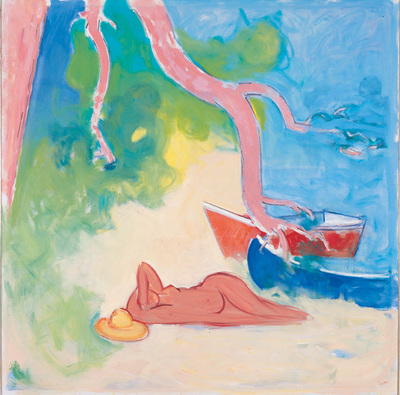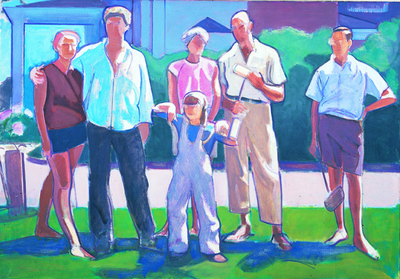Seeing It Loud in New York
by Henry McMahon
The National Academy Museum, on Fifth Avenue, is now hosting See it Loud, an exhibition of paintings by seven painters—Leland Bell, Paul Georges, Peter Heinemann, Albert Kresch, Stanley Lewis, Paul Resika, and Neil Welliver. Their deep influence on the sensibilities of at least two generations of painters in this city is reflected—some will think this perverse—in inverse proportion to their standing in the art market.
It’s a well-known story that the big budget galleries’ domination of New York’s artistic landscape has transferred influence away from teaching institutions and museums. Insofar as the Academy’s traditional role of disseminating the ideas of important artists has become the purview of the commercial gallery, Chelsea, more than any place, reflects the true academic art of our time. In this context, See it Loud is best characterized as an anti-academic show.

Paul Resika, August, 2007
That the careers of the seven painters have not stacked up against those of their contemporaries—pop artists, abstractionists, minimalists, conceptualists, neo-expressionists, post-modernists—is not lost on their admirers. The dubious distinction of relative obscurity in the face of extraordinary talent must be one of the threads that connected this diverse group of painters in the mind of curator Bruce Weber. The more obvious link is figuration—in each case aggressive and unapologetic—and one feels immediately upon entering the National Academy Museum that the connection between figurative painting and art world obscurity provides the subtext of this exhibition.
Leland Bell (1922-1991)
On the surface the exhibition is a celebration of representational painting—figures, landscapes and still lifes—and nowhere is the power of the genre on stronger display than in the narrow second floor room devoted to the paintings of the late Leland Bell, on whose work this review concentrates. Among the many demands that Bell’s paintings make on our attention, the question, “Why is this painter not more famous?” is a corollary to each.
Bell embraced figurative painting with something of a true believer’s zeal for the importance of the art form, and the paintings displayed are representative of the subjects he most commonly turned to: a self-portrait, family portrait, a large still life and two large figural compositions. The still life is a tour de force of the arrangement of forms in three-dimensional space, but it is the figural arrangements included here—a couple (he in bed, she standing nearby) reacting in surprise to a dead bird brought by a cat to their bedside, and a woman reaching forward impulsively toward a butterfly that’s come into her dining room, her companions caught off guard—that show the greatest realization of the painter’s ambitions. These works depict the small, everyday dramas of the domestic world—an ordered world of fruit bowls, heavy curtains and starched white sheets—as so fully permeating the lives of their protagonists that they come ultimately to define their very being.
Actions are immediate and unpremeditated. The surprise arrival of a butterfly as a table is cleared after dinner; a woman extends an arm in an impulsive lunge to make contact with the visitor, her other arm reaching back to give balance, like a fencer; a man looks to where she’s drawn his attention as he’s been making a point, in conversation, that is now secondary to the action in the room; a woman puts a hand on her hip and dips her head to see around the outstretched arm of her companion. The very spontaneity of actions gives tremendous urgency and animation to the picture. The butterfly is caught in the light against the dark lower corner of the canvas. It’s the compositional locus of the image, but also its raison d’etre; the butterfly’s arrival has given the figures a powerful moment of spontaneous and sinuous grace.
A light warm pink describes the top of a man’s arm against a bottom plane of deep umber shadow. These colors throb against the cold blue of the man’s shirt. Black lines describe the contour of the arm’s outer form, but within, the planes meet in a soft edge that links them as articulations of a shared form. The colors are pure and deeply saturated, and they pulse in their tonal and spectral relationship to their neighbors. The draftsmanship of the line is unfailingly beautiful. It articulates forms and volumes, but also shifting weights and masses. An arm, rendered as a relationship between two colors ringed in black, has all the structure, tone, and quickened surface of its real life counterpart.
Such is the language of Bell’s paintings. His forms are described by open planes of light and shadow, with nothing but the color’s saturation and a bold contour to animate them as realistic surrogates for their real-life models. It’s formalist painting, to be sure—Bell was known to have re-calibrated his figural arrangements over the course of years—but the engagement of color and line creates a near metaphysical contradiction between the two. Most modernists would be lucky to have lit upon such a dialectic (colori/disegno), and be content to explore its implications in the abstract, but Bell’s enthusiasms—he was a champion of Piero, Derain and Balthus—push him into pictorial depiction.

Leland Bell, The Croquet Party, 1965
It is by keeping with figuration that Bell avoids the fate of art for art’s sake, for in so doing he displays a pitch perfect conjugation of form and content. The drama of Bell’s paint, of his shimmering color and muscular draftsmanship, finds its highest articulation in the domestic drama that is his most profound theme. Paint and image are reflexive. The juxtaposition of a pink to a blue is not only a visual metaphor for drama but part of a pictorial depiction of drama. The thrust of an arm through space is not only a picture of dramatic action but also a dramatic thrust of creamy, glowing white into midnight planes of black and blue.
If the commercial apparatus of the art world has not yet made Bell’s paintings—and those of Georges, Heinemann, Kresch, Lewis, Resika, and Welliver—part of the blue-chip history of American modernism, we should be thankful for the National Academy Museum and all of this city’s old institutions that still maintain a mandate to tell aloud, and so well, their own impressive histories.
Henry McMahon is a painter and writer. He lives in Ridgewood, Queens. See It Loud: Seven Post-War American Painters continues through January 26, 2014 at the National Academy Museum in New York.
